Join a powerful, unprecedented alliance for better eye health for all.
Join IAPB-
Choose an alternate language here
Once a young businessman from Kolkata was searching for the ‘purpose of his life.’ Business had made him rich and successful but was it the purpose of his being? This soul-searching mission brought him to his maternal ancestral village of Mastichak, in the state of Bihar in India.
Spending time in the village over a period of time, this man realised that his true calling was to help the poor people who are blind see again. Then after four years of working for this cause, one day he witnessed a scene that made him realise his second true calling.
He noticed a little girl and her friends playing football with a rag-ball. A brief exchange revealed that this girl desired to play football but was convinced that she would never be able to do so because football was regarded as a sport for men and it was considered taboo for her to even consider playing it.
This made him realise how engrained patriarchal beliefs were in the society. It also opened up the possibility that if girls like her were given the opportunity to play football, it would undermine the very roots of patriarchy and enable others to realise that if given the chance, girls could be just as good as boys. This was a pivotal step forward in his work against gender discrimination and to improve equality.
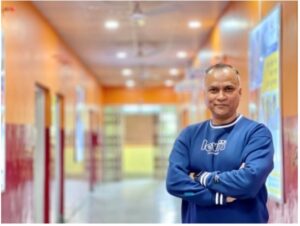
This person was none other than Mritunjay Tiwari, the founder of Akhand Jyoti Eye Hospital, which has provided rural eye care to more than a 15 million indigent people and nurtured 400 plus girls (at different levels of education or employment) since its inception 17 years ago.
Problem 1: As per the World Health Organization, around eight million people in India are blind. 63%of this blindness is due to cataract, which is easily curable. It is more rampant in areas that show poor social, economic, education and health indicators; as poverty results in higher levels of blindness and further aggravates existing poverty. Studies have also shown that the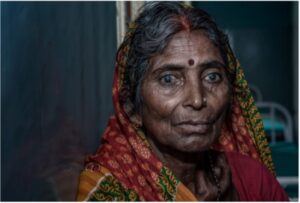
Problem 2: In much of rural India, women and girls don’t have the same opportunities as their fathers and brothers do. In places like Bihar one of the poorest states in India, many families can’t afford to keep all their children in school, so the girls drop out early. Some are married off while they’re still children. In these highly patriarchal society, women face considerable hardship and discrimination, in terms of right to education and employment. Social evils such as child marriage, dowry, domestic violence, low female literacy rate, and low female labour participation rates are rampant 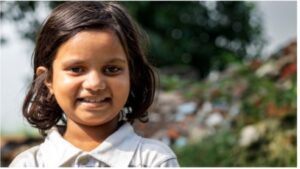
India therefore needs large scale eye care services to tackle the problem of blindness, and it needs to reduce gender discrimination and uplift women in order to develop. Both these factors can prove vital in the socio-economic development of the country. Poverty and women empowerment have a near-perfect correlation in the world of data. Mritunjay realised that attacking poverty and empowering women could be done in one approach. Hence, Akhand Jyoti started addressing both these problems through its two co-related programmes, namely the “Blindness Elimination” Programme and the “Football to Eyeball” programme.
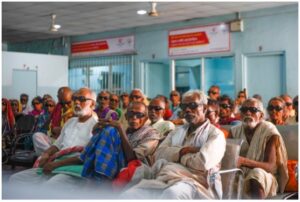
Soccer is hugely popular in rural India, but girls often aren’t permitted to play with the boys, even though many of them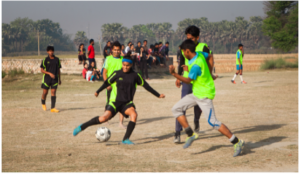
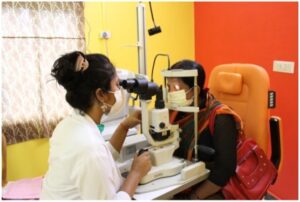
Presently Akhand Jyoti does over 75,000 sight-restoring surgeries annually, 80% of which are done for free for underprivileged patients. Through its 5 hospitals and 28 vision centres across Bihar and Eastern Uttar Pradesh it is continuing to provide affordable, accessible, sustainable and comprehensive eye care to the people of the region and empowering women to achieve this.
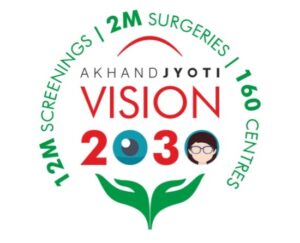
Through its “Blindness Elimination” and “Football to Eyeball” programmes Akhand Jyoti addresses 6 of the 17 Sustainable Development Goals of the United Nations, namely the goals of – no poverty, good health and well-being, quality education, gender equality, decent work and economic growth, and reduce inequalities.
Akhand Jyoti believes that the biggest legacy it can create for eye care in a low-income region like Bihar is to increase the number of beds for eye patients in the state. It aims to achieve this by building a 500-bed Centre of Excellence, building new Secondary Surgical Centres (where only cataract surgeries are performed), and upgrading existing Secondary Surgical Centres into Tertiary Surgical Centres (where all sorts of eye surgeries and treatments are done).
As part of its “Vision 2030” Akhand Jyoti plans to carry out 12 million eye screenings and 2 Million eye surgeries. The 160 vision centres that will come up by 2030, will work in tandem with the surgical centres in a hub and spoke model supporting the blindness elimination programme.
By 2030 Akhand Jyoti also plans to train 1,500 rural girls as professionally qualified optometrists to drive its blindness elimination programme.New hostels and infrastructure is being built to accommodate the additional new girls into the programme every year.
Today the soul searching mission of one man, to do something for the lesser privileged brothers and sisters of our society, is Eastern India’s largest eye hospital and a beacon of hope for rural underprivileged girls. Akhand Jyoti is more than an eye hospital, more than a girls programme, it is one man’s dream turned into reality through a dedicated team working to uplift rural India out of the shadows of poverty.